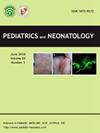Early- and late-onset candidemia in very low birth weight infants in the Korean neonatal network, 2013–2017
IF 2.3
4区 医学
Q2 PEDIATRICS
引用次数: 0
Abstract
Background
Candidiasis is a critical infection that is associated with very low birth weight (VLBW; <1500 g). This study investigated the characteristics and clinical presentation of candidiasis in Korean VLBW infants according to the onset of candidemia.
Methods
All VLBW infants with candidemia, defined as blood culture-positive candidiasis and registered in a multicenter database with data from 70 neonatal units of the Korean Neonatal Network between 2013 and 2017, were included in this study. Early-onset candidemia (EOC; ≤10 days) and late-onset candidemia (LOC; >10 days) were analyzed. The demographic characteristics, clinical presentations, and outcomes of candidemia were also determined.
Results
The overall incidence of candidemia was 2% (209/10,397) and 4% (173/3934) in VLBW and extremely very low birth weight (ELBW; <1000 g) infants, respectively. In ELBW infants, gestational age was significantly younger at EOC than at LOC (P = 0.015). Cesarean section, respiratory distress syndrome, severe bronchopulmonary disease, pulmonary hemorrhage, prior-bacteremia, neonatal seizures, and periventricular leukomalacia were significantly more common in the LOC group than in the EOC group (P < 0.05). The duration of invasive ventilation, total parenteral nutrition, and hospital stay were significantly longer in the LOC group than in the EOC group (P < 0.05). Most infections were caused by Candida spp. (91.8%). The mortality rate of ELBW infants with candidemia was 41%, which was higher than that of those without candidemia (29%) (P < 0.001). Mortality due to infection was also higher in infants with candidemia (55%) than in those without candidemia (15%) (P < 0.001); however, there were no significant differences between the EOC and LOC groups.
Conclusions
LOC was more common than EOC in VLBW infants. Considering the risk factors of LOC, active weaning from invasive ventilators and aggressive enteral feeding are required to decrease LOC. Furthermore, preventing candidemia is necessary to reduce mortality in VLBW infants.
2013-2017年韩国新生儿网络中极低出生体重儿的早期和晚期念珠菌血症。
背景:念珠菌病是一种与极低出生体重(VLBW)相关的严重感染:本研究纳入了所有患有念珠菌血症的超低出生体重儿,念珠菌血症的定义是血培养阳性念珠菌病,并在多中心数据库中登记了2013年至2017年间韩国新生儿网络70个新生儿科的数据。研究分析了早发型念珠菌血症(EOC;≤10 天)和晚发型念珠菌血症(LOC;>10 天)。研究还确定了念珠菌血症的人口统计学特征、临床表现和结果:结果:在超低体重儿和极低体重儿中,念珠菌血症的总发病率分别为 2%(209/10,397)和 4%(173/3934):在超低体重儿中,LOC 比 EOC 更常见。考虑到 LOC 的风险因素,需要积极从有创呼吸机断奶并积极进行肠内喂养,以减少 LOC。此外,预防念珠菌血症也是降低低体重儿死亡率的必要条件。
本文章由计算机程序翻译,如有差异,请以英文原文为准。
求助全文
约1分钟内获得全文
求助全文
来源期刊

Pediatrics and Neonatology
PEDIATRICS-
CiteScore
3.10
自引率
0.00%
发文量
170
审稿时长
48 days
期刊介绍:
Pediatrics and Neonatology is the official peer-reviewed publication of the Taiwan Pediatric Association and The Society of Neonatology ROC, and is indexed in EMBASE and SCOPUS. Articles on clinical and laboratory research in pediatrics and related fields are eligible for consideration.
 求助内容:
求助内容: 应助结果提醒方式:
应助结果提醒方式:


